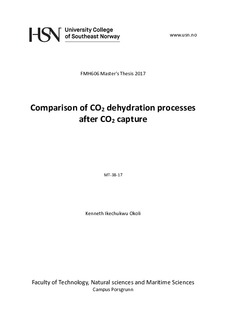| dc.description.abstract | This study compares two conventional methods of CO2 dehydration processes after CO2 capture and its suitability of use. The methods are Triethylene Glycol (TEG) absorption and 3A Molecular sieve adsorption. Chapter 1 and 2 covers an in-depth theoretical review of the processes and literature review, chapter 3 deals with the process description while chapters 4,5,6,7 and 8 analyzes the process simulation, dimension, cost estimation and its comparison. The results obtained shows that energy consumption in 3A Mol. Sieve adsorption is higher when compared with TEG absorption. The total installation cost of 1589.91 kNOK for absorber and desorber is higher when compared with 1115.99 kNOK for adsorption and regen/cooling tower. Thus TEG dehydration is recommended for large scale process unit as it has lower operating cost and lower energy consumption. In this report, TEG dehydration process was used to calculate the water content in dry CO2 gas from 22ppm to 48.9 ppm. For small scale process unit capable of lower water removal in dehydrated dry CO2 gas to as low as 0.1ppm, 3A Molecular sieve adsorption which has lower equipment cost is more preferable. | nb_NO |
